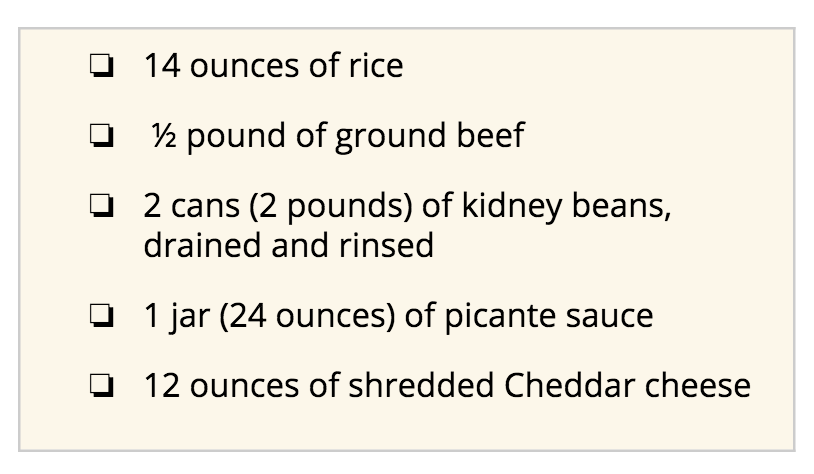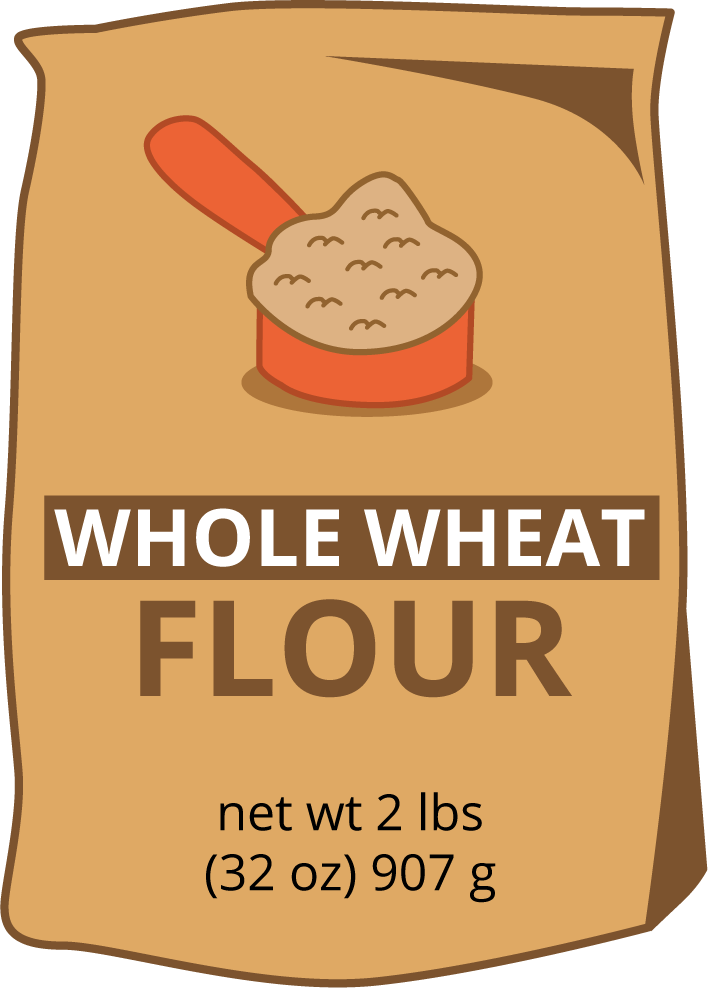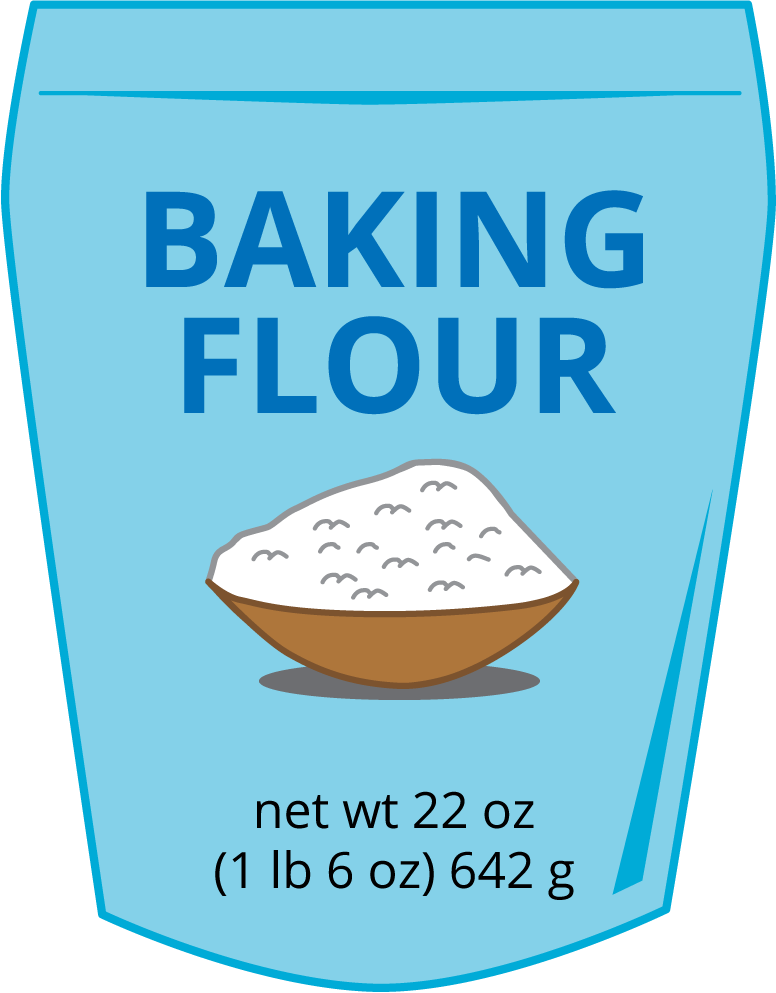Lesson 11
Pounds and Ounces
Warm-up: Notice and Wonder: A Recipe (10 minutes)
Narrative
The purpose of this warm-up is to elicit observations and questions about pounds and ounces in a familiar context, which will be useful when students reason about the relationship between the 2 units later in the lesson.
Launch
- Groups of 2
- Display the image.
- “What do you notice? What do you wonder?”
- 1 minute: quiet think time
Activity
- “Discuss your thinking with your partner.”
- 1 minute: partner discussion
- Share and record responses.
Student Facing
What do you notice? What do you wonder?

Student Response
For access, consult one of our IM Certified Partners.
Activity Synthesis
- “Can you tell which ingredient we need more of and which we need less of?” (We can tell we need more rice than Cheddar cheese, or more kidney beans than beef, but it’s hard to tell of which item we need the largest or smallest amount because the ingredients are not all listed in the same unit.)
- “Which item requires the largest amount? Which one requires the smallest amount?”
Activity 1: Pounds and Ounces (20 minutes)
Narrative
The goal of this activity is to build students’ intuition for 1 pound, 1 ounce, and the relationship between the two units. Students use labels on food packaging to reason about how pounds and ounces are related, and then use what they learn to convert pounds to ounces. Students reason abstractly and quantitatively when they determine the relationship between ounces and pounds from food labels (MP2).
Note that the quantities shown on food packaging or nutritional labels are often rounded rather than exact. For instance, a package labeled “32 ounces (2 pounds)” may contain 31.8 ounces but be labeled as 32 ounces or 2 pounds. In this activity, for the purposes of learning that one unit is 16 times the other, students will take the labels at face value. Consider explaining (during the activity synthesis) that, in reality, the label may not match the content exactly.
The blackline master includes images that can be used for the activity. If desired and if practical, actual packaged food could be used instead. In that case, be sure to choose items with whole numbers of pounds and ounces and to exclude items that show that 1 pound is equivalent to 16 ounces, as students reasoning about the equivalence is the point of the activity. Here are the images on the blackline master for reference:




Advances: Speaking, Representing
Required Materials
Materials to Copy
- Pounds and Ounces
Required Preparation
- Create a set of cards from the blackline master for each group of 4.
- If possible, gather examples of packaged food items—one that is labeled “1 ounce” and another labeled “1 pound”.
Launch
- Groups of 3–4
- Display (or pass around, if possible) a 1-ounce pack and 1-pound bag of some food items.
- “How do you think 1 ounce compares to 1 pound? How many times as heavy is 1 pound compared to 1 ounce?”
- Collect and record estimates.
- Give each group a set of images from the blackline master—one image per student.
Activity
- “Use the information on the images to find out how 1 pound and 1 ounce compare. Work with your group to complete the activity.”
- 8–10 minutes: group work time
- Monitor for:
- the language students use to describe the relationship between pounds and ounces
- the ways students reason about multiples of 16 as they complete the table (for instance, by adding 16 repeatedly, or by multiplying the number in pounds by 16, or a combination of the two)
Student Facing
Your teacher will show images of some packaged food items.
-
Use the information on the images to find out how pounds (lbs) and ounces (oz) are related.
- Write a sentence to describe the relationship between the two units.
- Use two pieces of information to show that your conclusion is right.
- Complete this table with amounts in ounces.
pounds (lb) ounces (oz) 1 2 3 4 5 8 10
Student Response
For access, consult one of our IM Certified Partners.
Activity Synthesis
- Invite selected students to share their conclusions about the relationship between pounds and ounces.
- Highlight explanations that make it clear that 1 pound is 16 as much or as heavy as 1 ounce.
- Display the table and invite students to share the amounts in ounces and their reasoning.
- If needed, point out that the abbreviation “lb” is used for pounds and “oz” is used for ounces.
Activity 2: Party Prep (15 minutes)
Narrative
In the first activity, students learned that one pound is 16 times as heavy as 1 ounce. Here they apply this knowledge to convert quantities into ounces and to solve multi-step problems. The quantities include a fractional number of pounds and one expressed in a combination of pounds and ounces.
As in earlier lessons in which they encountered a fractional amount of a unit of measurement, students are not expected to find the number of ounces in \(\frac{1}{2}\) pound by writing \(\frac{1}{2} \times 16\). Instead, they can reason about half of a quantity using their understanding of fractions and by dividing an amount by 2. Those who do write \(\frac{1}{2} \times 16\) represent the situation correctly, but this reasoning and the related operation will be developed in grade 5.
Supports accessibility for: Conceptual Processing, Organization, Memory
Launch
- Groups of 2
- “Let’s use what we know about pounds and ounces to solve problems.”
Activity
- 7–8 minutes: independent work time
- 3–4 minutes: partner discussion
- Monitor for different ways students reason about the last question.
Student Facing
-
A family is cooking for a party and needs to buy some ingredients for a main dish:
- 5 pounds of rice
- \(\frac{1}{2}\) pound of almonds
- 2 pounds 8 ounces of pinto beans
How many ounces of each ingredient does the family need to buy? Show your reasoning.
- To make the dessert, they need 6 pounds of flour. If they already have 40 ounces of flour in the pantry, how many more ounces of flour do they need to buy?
Student Response
For access, consult one of our IM Certified Partners.
Activity Synthesis
- Select students to share their responses and reasoning. Record their responses for all to see.
- Clarify that sometimes both units are used to express a quantity that is not a whole number of pounds (as is the case with “2 pounds 8 ounces of pinto beans”).
- Select students who used different strategies to solve the last problem to share.
Lesson Synthesis
Lesson Synthesis
“Today we learned about the relationship between pounds and ounces and solved some problems that involve those measurements.”
“When you weigh yourself, the scale likely gives your weight in pounds. If the scale is set to measure in ounces, will the number be larger or smaller? How much larger or smaller? Why is that?” (Larger, 16 times larger, because there are 16 ounces in 1 pound, so the amount in pounds needs to be multiplied by 16 to get the equivalent in ounces.)
“How is the relationship between pounds and ounces like that between kilograms and grams?” (One unit is larger than the other.)
“How is it different from the relationship between kilograms and grams?” (In pounds and ounces, the larger unit is 16 times the smaller one. In kilograms and grams, the larger unit is 1,000 times the smaller one.)
Cool-down: Hungry Birds (5 minutes)
Cool-Down
For access, consult one of our IM Certified Partners.